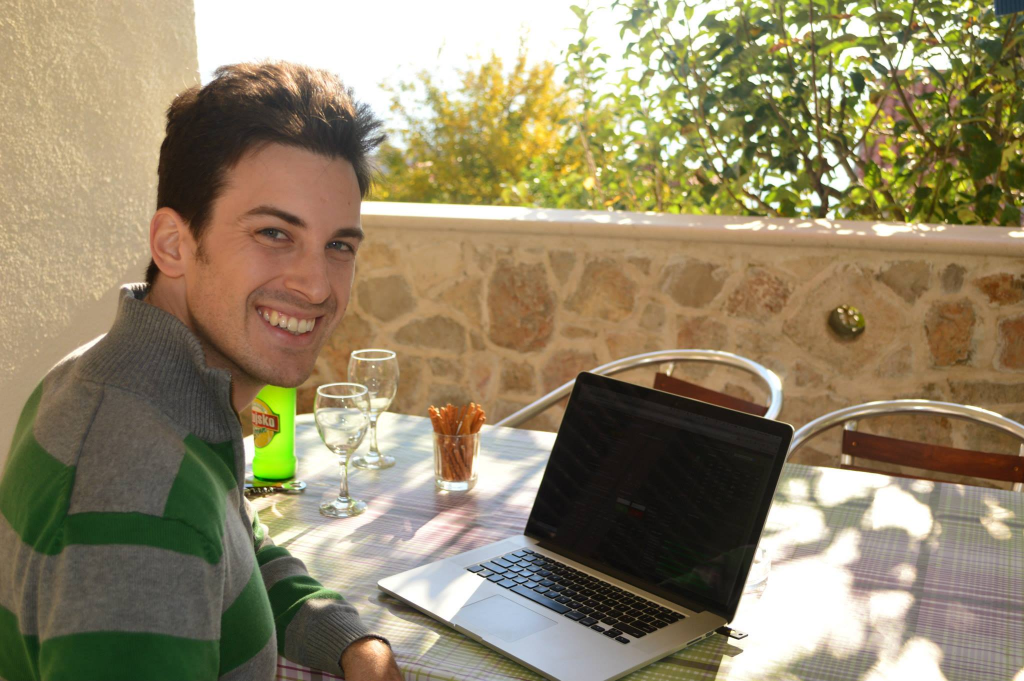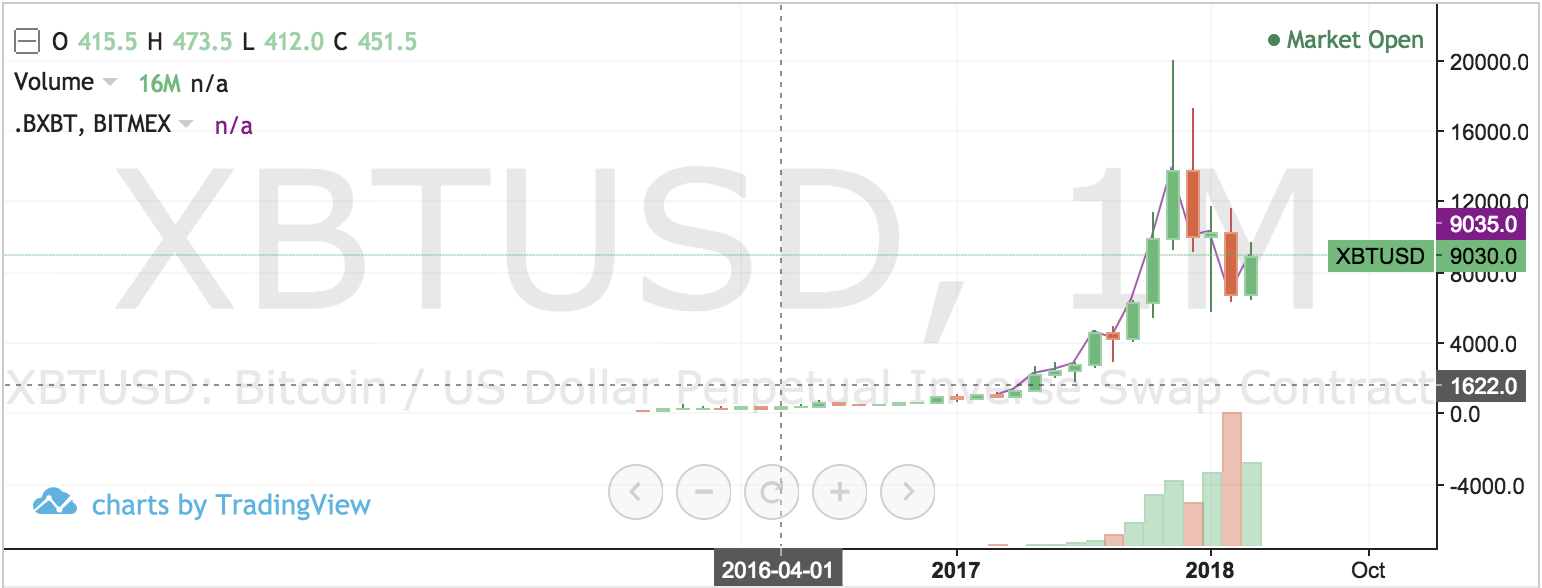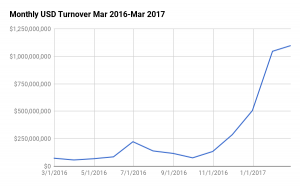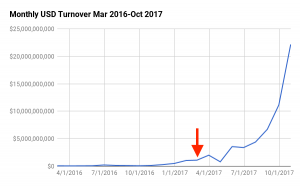Hi there – I’m Samuel Reed, CTO of BitMEX.
It’s been an incredible journey over the last four years building BitMEX. When we started, I don’t think any of us could have imagined the success this platform would achieve or how it would come to dominate Bitcoin/USD trading in 2018.
From 2014 to today, the BitMEX platform has grown from zero to an average of $3B of trading volume per day. Our flagship product, XBTUSD, trades more than any crypto product in the world. We serve customers all over the world, in five languages, and have become the premier platform for Bitcoin price discovery and liquidity.
The BitMEX team has been hard at work improving capacity, building a solid mobile offering, and creating a tech team that is truly best-in-class. We are not resting on our laurels, enjoying this success for the sake of it. Quite the opposite: we’ve been busier than ever.
We’d like to let the community in on how we formed and how we’re moving forward. As was wisely said: “In order to defeat the bug, we must understand the bug.”1
Origins
I’ll begin with a true story.

In 2014, I was speaking at a web development panel in Hong Kong for General Assembly, a coding bootcamp. They wanted to give their soon-to-graduate students a taste of what it was like to work professionally. I took the opportunity to talk about my history: a career made of positions in several small businesses, startups, and government – with an emphasis on how incredibly in-demand software engineers are.
A rather loud personality in the back asked a question: “How do cash-poor startups looking for a CTO make a case? How do you attract great talent in such a competitive atmosphere?”
“Well, that’s a good question, and a tough answer,” I said. “Without funding, you have the challenge of a serious risk versus a sure thing. Why should any experienced developer forgo $200,000 or more at a large tech company, in a comfortable, resource-rich environment, to work 80 or more hours a week? You essentially have to find some bozo” – I really said this – “who believes in your idea so much he’s willing to take the risk despite so many better options.” I wished him good luck and we continued the panel.
He came up to me after the panel and told me he wanted to do a Bitcoin derivatives exchange. I knew then: I was that bozo, and Arthur Hayes and I were to become business partners.
Without any major funding, we brought an alpha online within six months and started with the BitMEX Trading Challenge, an no-rules trading competition where we put the exchange through its paces. And it really was no-rules (aside from multiple accounts) – hacking the site would win you the prize. We paid out a few Bitcoin in bug bounties in those days but we didn’t have any major failures.
Much to the annoyance of my wife, we launched BitMEX on during our honeymoon in Croatia, on November 24, 2014. Ben and Arthur celebrated separately, in Hong Kong. Notice the original trading interface in both photos. You can still read the original Trollbox messages from that day.


Building BitMEX, 2014
All projects are a product of the time in which they are built. In early 2014, the crypto ecosystem was reeling from the vacuum Mt.Gox left behind. The focus at the time was not “proof of work” vs. “proof of stake”, as it is today, but a forgotten term called “proof of reserves” – just Google it and look at the timestamps of all the popular posts. In fact, a question about this was the top-voted comment on our Reddit launch announcement.
The first rule of running a Bitcoin exchange is, and always has been, “Don’t lose the Bitcoin.”
This rule pervades everything we do at BitMEX. It permeates our policy, even today: we still use a 100% cold wallet where every transaction is multisig. Look up a 3BMEX transaction on the blockchain, and you’ll see it. For 1,250 straight days (!), at least two out of the three of us have gotten up, read the day’s withdrawals, done our risk checks, and signed, to be passed onto the next partner for signing and eventual broadcast.
At the time, I thought users would resist this. Yes, Bitcoin is better in so many ways than any monetary system that has come before it. But it is weaker too. Custodianship is an unsolved problem that requires constant vigilance. I think our customers know this and appreciate it. In our early days, we received a large number of complaints about withdrawal times. Today, where we are the largest exchange by volume in the world, we receive barely any. People get it – caring for your deposits this way is not easy. We do it not because it is convenient, but because it is safe.

The atmosphere in 2014 influenced how we built BitMEX. My frontend experience lead me to adopt ReactJS for the frontend. BitMEX was the first exchange to launch with it, a choice that has paid dividends well into 2018.
We were also the first – and likely still the only – exchange to build our matching and margining engine on kdb+/q, a technology traditionally used for querying of large-scale time-series data. It’s a natural fit. It’s fast (bear with me), using SIMD instructions to greatly boost throughput, it’s flexible, and it’s accurate. Kdb+’s flexibility and speed allowed us to pivot our product offerings twice: from low-leverage inverse and quanto futures to high-leverage ones, and from high-leverage futures to our flagship product, the XBTUSD Perpetual. We also pivoted loss-recovery mechanisms twice, from guaranteed settlement, to Dynamic Profit Equalization, to ADL.
BitMEX is a company known for listening to its customers and adapting. This required flexibility, innovation, and a lot of sweat equity from everyone on the team, and we’re so proud of how far it’s come.
Now, it wouldn’t be fair to come this far without addressing the title of this post. BitMEX now trades as much as US$6.5 billion per day. Our most recent 1-minute record was US$35 million, a number that is higher than the entire month of April 2016.

The following charts show monthly turnover in increasingly large timescales, to highlight detail completely lost in the overall view:
To understand why BitMEX is experiencing slowdowns, despite using a solid technology like kdb+, it’s important to understand what BitMEX does differently than other exchanges.
100x is a number that elicits a large number of reactions, ranging from “are you crazy?” to “how is this possible?” It is only possible due to incredible financial engineering from our co-founder and CSO Ben Delo. Ben is a diligent and brilliant mathematician. He built a perfect mathematical model for trading, a constantly-coherent system that continuously audits all trades and always sums to zero. Transactions don’t get lost in the BitMEX engine. A user’s balance never goes negative. There are entire classes of bugs that are common on other platforms that never occur on BitMEX, and it is that attention to detail that makes all the difference. Mark/Fair Pricing, the weighted ADL system, perpetual contract funding rates, and live isolated/cross remargining are all new, novel concepts that did not exist before BitMEX.
This consistent coherency inside the BitMEX engine makes 100x possible. Kdb+ has historically been fast enough that we can continuously remargin all positions upon each and every price change. This provides the safety and speed necessary to not only survive within the razor-thin requirements of 0.5% maintenance margin, but thrive. The BitMEX Insurance Fund, a fund that guarantees settlement of BitMEX contracts, contains (at the time of writing) an incredible 6,149 XBT, over US$50M. Competing firms have insurance funds in the single digits of Bitcoin, despite offering as low as only 20x leverage.
BitMEX won’t sacrifice safety for speed. The security of our users’ funds and confidence in their trades is paramount. But we hear all of you: you want to trade faster, you want freedom from “System Overload” messages, and we will give that to you.
Since late 2017, the BitMEX team has refocused on engine performance as our highest priority. We have built, and are continuing to build, a team full of the top professionals in the space. This team works hard, building capacity for the next 100x increase in trading volume.
In the second part of this series, I’ll explain in-depth:
- How the BitMEX engine processes orders and remargining
- How real-time messages flow through our system to your browser
- How BitMEX uses API-first design to provide the most powerful API in the business
- Performance charts showing hot-spots, peak versus baseline load, and corner-cases
- A breakdown of the dreaded “System Overload” message, and how it is generated
In the third part, I’ll also explain:
- Performance numbers showing how capacity has increased since 2017
- We have made large strides in the past months – but demand has increased to match
- Roadmaps and pending work for Q2
- BitMEX’s vision for the future of online derivatives trading
Thank you to all of you for being a part of BitMEX’s success. Ben, Arthur and I feel fortunate than to be a part of such a great company: our customers, team, and market opportunity are simply best-in-class.
Reach out to me directly on Twitter at @STRML_ and on Telegram at STRML. I also occasionally talk with traders on the Whalepool TeamSpeak, a fun community of traders that have given great feedback and encouragement to BitMEX for years.

1 – Starship Troopers was ahead of its time with its views on software development.



